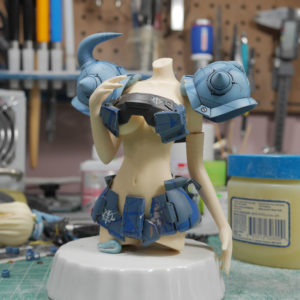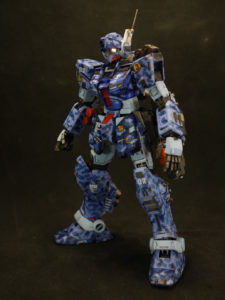Time for another Ver Ka Sazabi update. Today’s update will cover the process of making LED embedded resin thruster parts. The why of it all, well, we’ll get into that later. Going back to when the kit was sanded and dismantled; the thruster pieces were singled out and I started to plan out the process for adding some lighting mods. I had lit the HGUC Sazabi, so I figured this much larger scale shouldn’t be much of an issue. My experience from working with lighting the 1/144 scaled Sazabi helped make my decision on the direction.
Seven thruster parts are identified. Granted, I’m ignoring the square thruster pieces all over the body, as well as the round one at the back skirt – there’s something to be said about going overboard with lights. And these seven, effectively 14 thruster pieces should be enough for the effect.
With these seven thruster parts picked out, the LED count for just the bells is 32. Lets do this!
The first step, again, from my experience with the lil’ Saz is to make molds of the bells first. The bells are gathered and placed into a Lego enclosure. Legos are great for mold making as you can get various block and fairly water tight seals, water tight enough for the silicone in liquid form. The bottom of the square blocks is filled with a layer of play dough. The thrusters are placed on top of this layer of play dough. The play dough acts as an anchor for the parts as well as a stop zone for the silicone.
I’m using is a green 25 duro silicone. Mixed by weight at a ratio of 10 to 1, rubber to catalyst, the molds are poured and pressurized to reduce air bubbles. Once one side is made, the play dough is removed and the mold with the thruster bells are washed and dried. Vaseline is lightly brushed over the side that was sealed with the play dough and replaced into the Lego blocks, and the second half of the mold is poured.
Part orientation and how you mold/cast a part is very important to making things more difficult or easier. It would have been much easier to cut and sand down the thruster bells that were connected together. Live and learn. Now for the main part pieces, the bells are glued into position for as airtight/water tight seal as possible. Then placed onto a play-dough bed with bits of cut up cured silicone from older molds as filler materials. This is the first section of a planned two part mold.
As explained with the thruster bell molding, the first part of the mold is removed from the lego encasing and the playdough under layer is removed. The mold is then washed and dried and prepared for the second silicone filling of the two part mold.
The thruster bells are cast and cleaned up. LEDs are then glued to the thruster bells. In some cases, the LEDs will fit nice and snugly into the thruster bell holes, but again, to ensure as water tight a seal, they are best glued. One thing I learned in this gluging process is that one should never use CA glue with LEDs. The CA glue makes the LED body brittle, and slight amounts of pressure will break the LED. I now use a 5 minute epoxy glue to attach the LEDs to the thruster bells. Once the glue has set and cured, the LED leads are trimmed and wired to one another in parallel.
This brings about the point on wire planning. Depending on the power source and the power requirement of the LEDs (each color has different power requirements), I can wire the LEDs in series or in parallel. Math is involved here. Since I want the power source to be self contained inside the kit, I will be using a smaller power source which then dictates that the parallel wiring scheme best fits my situation.
Once the LEDs are wired, the entire assembly is place bell/LED assembly into molds. Since I cast the parts with the bells glued, I can now place the LED bell assembly into the bell portion of the mold. The rest of the mold is filled with a 2 part resin mixed by weight at a ratio of 1 to 1. The 3 minute resin is quickly placed into the pressure pot before it starts to cure.
Once the parts are demolded, the part is tested to make sure the LEDs are still working. Here is a comparison of the original part and the cast part. For this particular piece, I decided to use the original bells. This was decided at the mold planning.
The process is then repeated for the rest of the thrusters. Some parts were similar in design and hence easier to plan and cast, others needed some reevaluation and a redesign in the mold.
So at this point, I’ve done all this work to replicate the parts with embedded LEDs. It would have been just as easily to drill some holes and pop the LEDs into the original parts. Now I’ll attempt to answer the begging question, Why bother with all this casting?
Again, from my experience with the smaller scaled Sazabi, I found that some parts, no matter how much drilling or putty, would just been too difficult to add LEDs, some of the smaller parts such as the forearm thrusters and the upper shoulder thrusters (both of these a specific add to the original Saz design). I have also found that once I had all the LEDs wired up and attached to the original parts, I had a mass of wire s and LED bodies protruding from the original parts. And I have to do this custom work to both sides, which significantly lowers the possibility of getting close to identical parts.
Solution, cast the LEDs inside the parts. No drilling in to the originals. I can make multiple copies that are close to identical. All the wiring between the LED sets are hidden inside the resin. Looking at the below example, the part is then just plugged in with little to no modification needed on the original connecting piece.
If that doesn’t sufficiently answer the why for some folks, well, then because I could, so I did.
All said and done, 7 different parts molded, which equated to 14 total parts being casted for the suit using 32 individual LEDs – yeah this took a while. I’ve been documenting the process from the start of work on this model. I’ve decided to take the approach of posting completed sections, or as close to completion as some modification processes can get. This sort of keeps the focus on certain aspects of the build with out jumping all over the place. It’s good to be organized I guess.
With the above said, I did do a quick little detail mod to the fuel tanks. Some sheet styrene is laid out and after some measurements were taken of the fuel tanks, a pencil and ruler are employed first, then the styrene is cut. A duplicate is made since there are two fuel tanks. The cut styrene sheet is then glued to the fuel tanks and painters tape is used to help keep the styrene attached to the fuel tanks while the glue welds the plastic plate to the plastic tube.
With the styrene detail in place, some holes are drilled for future placement of some metal minus mold details that should complete the quick detail modification. I still may add a panel line, but I want to see what the part looks like in a single color, so I’ll hold off on that decision until after I’ve primed the tanks.
Next update should finally get some visuals on the paint scheme. Stay tuned!



































Your level of dedication shows!
HAHAHA… funnier that this is coming from you. Have you picked up one of these? Turn it from Ver Ka to Ver Izu.